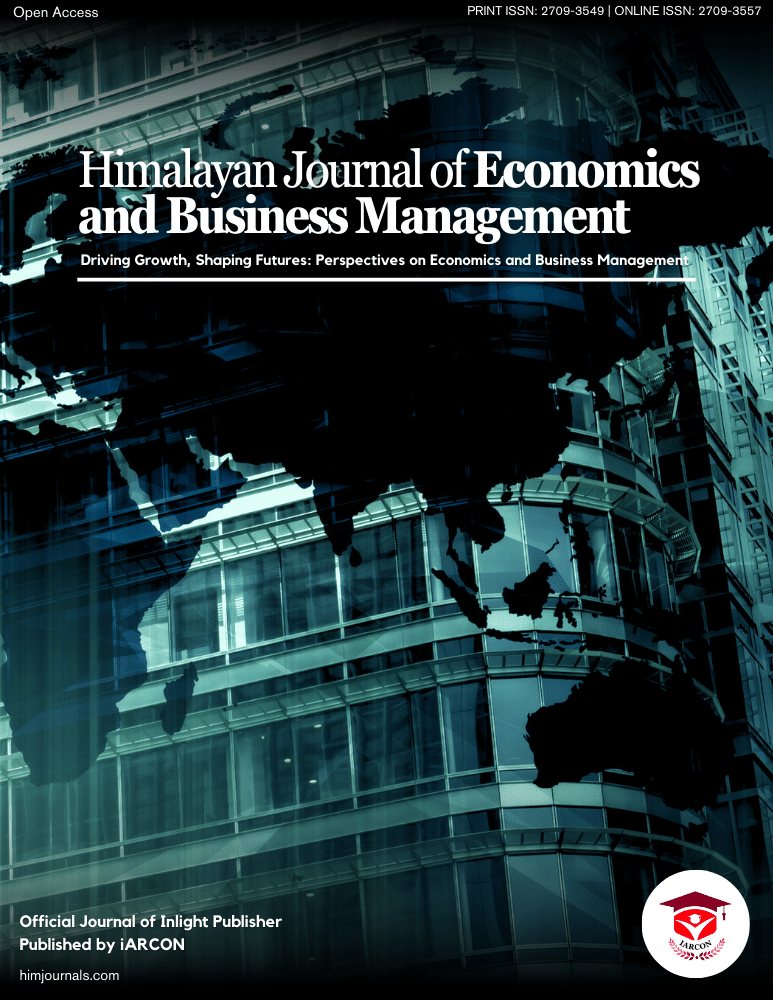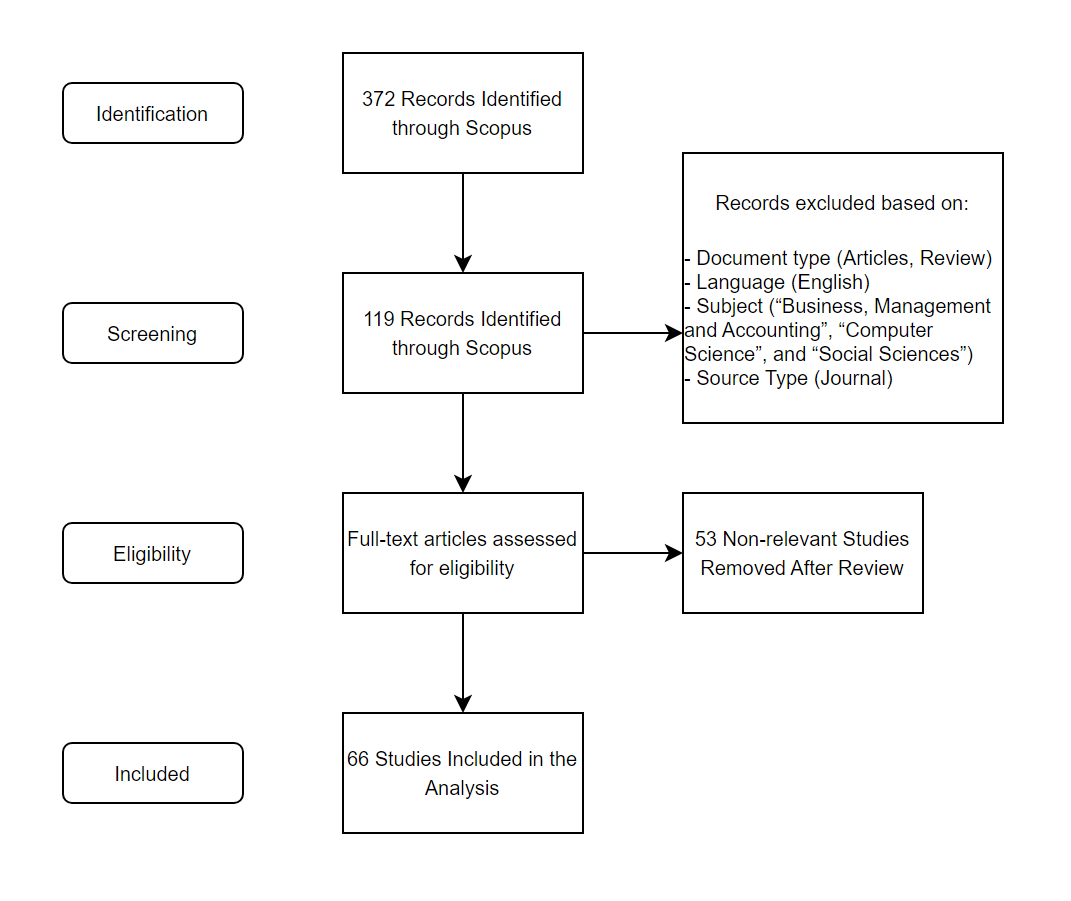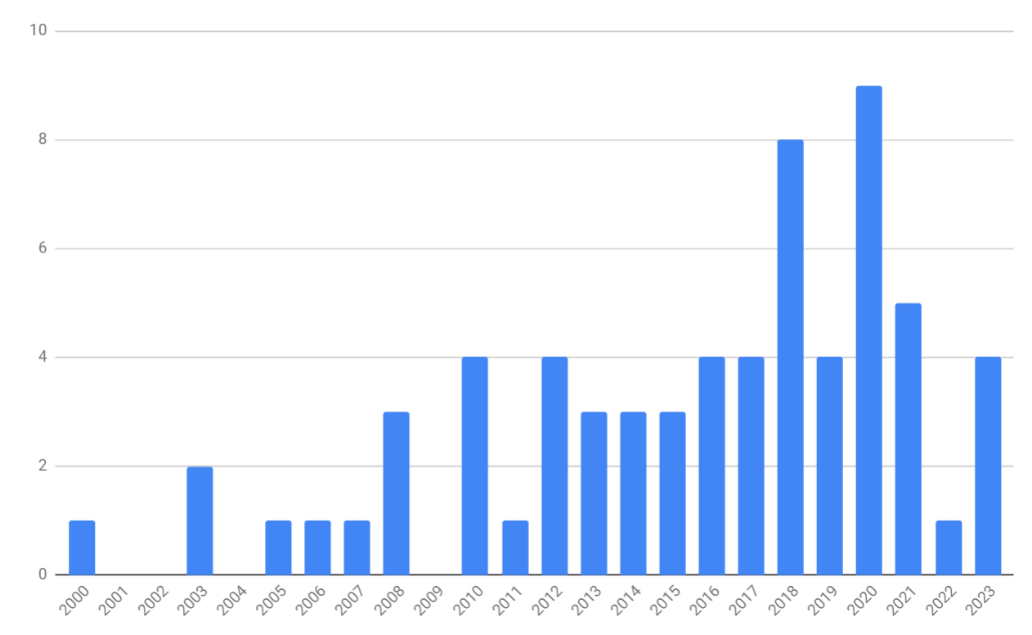The landscape of affiliate marketing, as comprehensively analysed through literature review, reveals a complex and multi-layered arena. It involves a diverse array of stakeholders including merchants, content creators, consumers and technology providers, each contributing to its vibrant dynamism. This field is characterized by its continuous evolution, marked by significant challenges and propelled by innovative breakthroughs. The interplay of various elements within this ecosystem makes affiliate marketing a fascinating area of study and application. In detail, the result of the synthesis of each thematic group is as follows.
Strategic Focus and Performance Measurement
In the realm of affiliate marketing, strategic focus and performance measurement are paramount, with trust between affiliates and merchants being a critical factor. Becker and Riedel [41] highlight the significant impact of cross-border tax effects on affiliate investments and performance, while Beránek [45] emphasizes the necessity of commitment and active participation in in-house affiliate marketing networks for effective performance measurement. The user click path, a vital metric, is shaped by various factors, from the diversity of text links used by affiliates to merchants' search engine advertising strategies [36]. This complex process involves user interactions that are not isolated but part of a click-to-lead-to-sale sequence, influenced by cultural and sectoral differences, underlining the importance of understanding customer evaluation models for optimizing affiliate marketing strategies.
The governance of affiliate-merchant relationships adapts to the level of environmental uncertainty, with a shift towards behaviour-based control systems in high-uncertainty scenarios or larger team sizes, contingent on the merchant's risk tolerance and monitoring capabilities [12]. Preferences for control systems differ among affiliates; content providers often prefer behaviour-based systems, while shopping incentivises opt for outcome-based systems. Contractual terms, such as pay-per-lead for one-to-one partnerships and pay-per-conversion for broader networks, are crucial in addressing issues like double marginalization and free-riding, tailoring relationships to specific affiliate types and merchant needs [64].
Ultimately, the efficacy of affiliate marketing networks hinges on the quality of organizational and managerial practices. Success is achieved by fostering win-win relationships, ensuring continuous communication and trust, setting clear and measurable goals, offering appropriate incentives and maintaining high standards. These factors are the bedrock of strategic focus and performance measurement, integral to the synergistic interaction between affiliates and merchants and are key to driving performance and strategic outcomes in affiliate marketing endeavours.
Technological Advancements
Technological advancements play a crucial role in shaping the landscape of affiliate marketing. Recent studies, including those by Ashok et al. [18], have placed significant emphasis on the importance of e-business analytics, employing tools such as ETL and Self-Service Business Intelligence to strategize effectively in affiliate marketing. This analytical approach is complemented by the burgeoning field of mobile marketing, where evolving strategies for monetizing applications underscore the need for businesses to effectively harness mobile platforms. Concurrently, an integrated approach to affiliate marketing, focusing on interaction models and varied pricing strategies for optimizing mutual benefits in affiliate partnerships, has been highlighted in studies like that of Libai et al. [64].
In the broader context of online marketing, the intersection of technology and strategy becomes evident through four key areas: social media marketing, customer relationship management, affiliate marketing and word-of-mouth marketing. Each strategy presents unique advantages and challenges, as explored in comprehensive literature reviews and case studies, including Duffy’s exploration of the impact of affiliate marketing on e-commerce [1]. The common thread across these studies is the need for an adaptive and informed application of these strategies to fully leverage their potential. Additionally, the integration of Semantic Web data into Web applications, as discussed by Stolz and Hepp [16], marks a significant advancement towards more interconnected and intelligent web platforms.
Furthermore, the aspect of security in technological advancements in affiliate marketing is underscored by the work of Iwashita, Tanimoto and Tsuchiya [15], who focus on the development of a highly secure transaction system. This emphasis on security is a vital consideration in today's increasingly digital and cyber-focused landscape. In addition, the innovative approach to information disclosure schemes, as examined by Suryanarayana et al. [30], highlights the importance of strategic information management in technological ecosystems. These advancements indicate a shift towards more sophisticated and secure systems in affiliate marketing, addressing key issues such as data privacy and transaction security, which are essential for maintaining trust and efficiency in the rapidly evolving digital marketing environment.
Consumer-Centric Approaches
Consumer engagement in affiliate marketing is significantly influenced by an understanding of different consumer profiles and behaviours. The work of Ballestar et al. [28] on customer segmentation in e-commerce, along with Christino et al. [35]'s exploration of consumer affiliation to cashback programs, highlights the importance of tailoring marketing strategies to diverse consumer preferences. This approach is further reinforced by insights into the spectrum of user profiles within affiliate marketing platforms, ranging from immature referees to highly engaged convenience buyers. Each segment exhibits unique engagement levels and profitability, necessitating targeted marketing strategies. Additionally, the role of backlinks, referral domains and linguistic styles in enhancing brand engagement emphasizes the nuanced factors that influence consumer interactions [8].
Several determinants are pivotal in shaping the adoption of affiliate marketing strategies by SMEs, with perceived usefulness, observability and social influence recognized as significant influencers [38]. The presence of a developmental organizational culture moderates these determinants, indicating the impact of an organization's internal environment on the effectiveness of affiliate marketing. Moreover, the strong impact of affiliate marketing content on consumer purchase decisions underscores the vital role of compelling digital content in driving sales and enhancing brand presence [46]. Advanced mechanisms, including transparent information disclosure and dynamic pricing, are suggested for improving profitability and catering to varying consumer needs.
The use of advanced technologies, such as machine learning and artificial neural networks, is transforming the landscape of affiliate marketing. The predictive power of these technologies, particularly in forecasting the quality of new customers referred by existing ones, is noteworthy. Transactional histories of referrers emerge as key indicators of prospective customer quality. Furthermore, integrating factors like ease of use, personal capacity, perceived risk and behavioural considerations into consumer behaviour models accounts for a significant portion of variance in consumer responses. These insights collectively suggest that leveraging these dimensions can lead to more effective and nuanced affiliate marketing strategies, better aligned with consumer behaviour and preferences.
Ethical, Fraud and Security Concerns
Affiliate marketing, while a potent tool for business growth, is not immune to ethical concerns and fraudulent activities. Studies by Amarasekara and Mathrani [2] delve into the challenges of controlling risks and fraud in this domain, providing critical insights into the balance between effective marketing strategies and ethical practices. Furthermore, Amarasekara et al. [50] explore specific fraudulent activities like cookie-stuffing and stalking, which have become prevalent issues in the industry. These unethical practices not only undermine the integrity of affiliate marketing but also highlight the urgent need for stringent ethical standards and robust monitoring systems to safeguard all stakeholders.
The landscape of affiliate marketing is further complicated by a variety of ethical and fraud concerns, which disproportionately affect large networks such as CJ Affiliate and Rakuten LinkShare. Despite the predominance of honesty within the affiliate community, over a third of publishers in affiliate programs have been implicated in fraudulent tactics, impacting the industry's credibility. In sectors like sports betting, ethical dilemmas become even more pronounced, with marketing strategies potentially exploiting vulnerable consumers [47,63]. To combat these challenges, the implementation of transaction reconciliation applications, refined cookie tracking controls and increased education about affiliate marketing technologies have been suggested, aiming to foster a more transparent and responsible marketing environment.
Amarasekara and Mathrani [2] mentioned that technological advancements in affiliate marketing have led to the development of innovative tools such as the Affiliate Marketing Network Simulation and Testing Environment (AMNSTE). This tool is designed to simulate affiliate networks and detect fraudulent schemes, while also providing behavioural data on customer purchasing patterns. However, the current methods of online cross-domain tracking face challenges in reliability and privacy concerns, varying in their degree of intrusion and technical necessity [53]. As the affiliate marketing industry continues to evolve, it is imperative to maintain a vigilant and proactive approach in ensuring ethical responsibility and security for all parties involved, balancing technological advancements with the need for ethical and secure marketing practices.
Marketing Communications and Social Media
The transformative impact of social media on affiliate marketing is increasingly recognized. Duffy's [1] research underscores how the landscape of marketing communications, particularly in e-commerce, is being reshaped by social media and digital platforms. This evolution is further exemplified in Mariussen's case study [58], which highlights the significance of effective communication in the development of in-house affiliate marketing networks. These studies collectively point to the growing importance of social media platforms in strategizing and executing affiliate marketing campaigns, emphasizing the need for businesses to adeptly navigate these digital spaces to enhance their marketing effectiveness.
In the realm of betting and gambling, social media's role is complex yet influential. Affiliates, through their social media activity, significantly impact bettors' behaviours, especially with medium complexity bets. This influence, however, varies with bet complexity and the bettors' account types. The Problem Gambling Severity Index (PGSI) score is a critical determinant in this dynamic [47]. Interestingly, gambling operators and affiliates use different strategies on social media, with the latter often resorting to emotional appeals, scarcity and urgency, yet both groups seldom promote responsible gambling. In terms of disclosures in affiliate marketing, there's a notable deficiency with only a small percentage adhering to FTC guidelines [9]. The effectiveness of 'Explanation' disclosures over 'Affiliate Link' types and the role of tools like AdIntuition in identifying affiliate content highlight the need for more transparent practices in this digital marketing sphere [25].
The crafting of engaging content, especially in email marketing, is crucial in capturing consumer interest, a strategy that is widely employed by cosmetics companies on social media. The focus on main promotional sections and product offerings underscores the strategic use of social media in these companies' marketing mix, with cost-per-click/pay-per-click being a predominant strategy. This trend not only reflects the critical role of social media endorsements in the cosmetics industry but also indicates the broader implications for affiliate marketing strategies. The effective utilization of social media platforms, coupled with clear and ethical communication, is essential for modern affiliate marketing campaigns to succeed and resonate with their target audiences.
Economic and Financial Implications
The financial and economic dimensions of affiliate marketing are pivotal for grasping its overall impact. Berger's research [20] delves into the commerce-oriented revenue models for content providers, illuminating the financial aspects of affiliate marketing strategies. This is complemented by Beránek's study [61], which offers insight into the economic considerations essential for the development of an in-house affiliate marketing network. These studies collectively underscore the significance of understanding the intricate financial models and economic factors that underpin successful affiliate marketing initiatives.
In the diverse sectors where affiliate marketing is applied, its impact varies. For example, in cryptocurrency wallet applications, affiliate marketing metrics are shown to influence user engagement metrics like pages per visit, albeit without significantly boosting organic traffic [52]. This effect differs in the supply chain sector, where the impact on website visibility depends on the traffic source [39]. The market potential of affiliate marketing also varies across different industries, with a notably higher success likelihood in the credit card market compared to the mortgage market, influenced by factors such as search engine rankings and content organization [24]. Moreover, the influence of commerce-oriented revenue models on the credibility of product-related content highlights the critical role of trustworthiness in affiliate marketing scenarios. In contrast, tax policies are shown to influence foreign affiliate investments significantly, with the reduction in statutory tax rates in the parent country potentially boosting investments, while lower withholding tax rates in the host country might have the opposite effect [41].
The structural and management aspects of affiliate networks have profound implications as well. The preference for in-house staff or outsourced specialists can influence the balance between expertise, scale and the protection of merchant interests. While network managers are adept at addressing clear violations, their responses to grey-area practices can be varied, often influenced by the potential increase in their fees. In the hotel industry, for instance, chain affiliation can enhance strategic entrepreneurship by providing access to vital resources and networks, thereby boosting performance and customer satisfaction. These findings highlight that the revenue models adopted by content providers significantly influence their perceived trustworthiness and credibility, with affiliate marketing models often perceived as more trustworthy. This insight is particularly relevant for content providers seeking sustainable and credible revenue models in the digital economy.
Broader Marketing and E-commerce Trends
In the broad scope of e-commerce and digital marketing, affiliate marketing emerges as a pivotal element. Studies like Becker and Riedel's [41] on the cross-border tax effects on affiliate investments shed light on global trends in affiliate marketing. This complements the insights provided by Libai et al. [64] regarding referral fees in affiliate marketing, which are crucial for understanding the evolving landscape of e-commerce and digital marketing. These studies highlight the intricate dynamics and global impacts of affiliate marketing in the digital economy.
In this rapidly changing environment, creating mutually beneficial relationships between advertisers and affiliates has become essential. The emphasis on affiliate marketing as a strategic tool for e-commerce businesses is evident in how consumer attitudes are shaped by factors like trust, informativeness and incentives [22]. Companies like AFP Innova demonstrate this through strategic differentiation and innovative marketing approaches, which significantly impact their growth and profitability [56]. This approach, along with the nuanced understanding of various markets and the implementation of Direct Marketing Capabilities (DMC), especially in non-metropolitan areas, exemplifies the diverse strategies needed for success [34]. Additionally, the adoption of e-commerce and Application Service Providers (ASPs) varies across industries, with factors like cost savings, efficiency and improved customer service driving adoption, while challenges like security concerns and customer demand act as barriers [42]. Effective internet marketing communication in both B2B and B2C markets hinges on a profound understanding of audience characteristics, message content, design and delivery [59].
The influence of cultural factors on the effectiveness of different advertising channels is also critical [3]. On-demand channels, for instance, have a more significant impact on short-term success than push-channels, underlining the importance of tailored advertising strategies [54]. In the field of ICT, the development of risk assessment technologies based on user behaviour and PC operations logs demonstrates the broadening application of these technologies. Despite obstacles such as high operating costs and unreliable internet, regions like Malawi are embracing online digital marketing strategies, utilizing channels like email, social media and affiliate marketing [44]. They are adapting with tactics like mobile apps and frequent website updates to enhance digital marketing performance. Overall, these thematic areas offer a comprehensive view of the current state of affiliate marketing, underscoring its dynamic nature, the challenges it faces and the innovative solutions being developed and implemented. As the field of affiliate marketing continues to evolve, these themes are likely to remain crucial in guiding strategy development and refinement in this vibrant and ever-changing sector.





